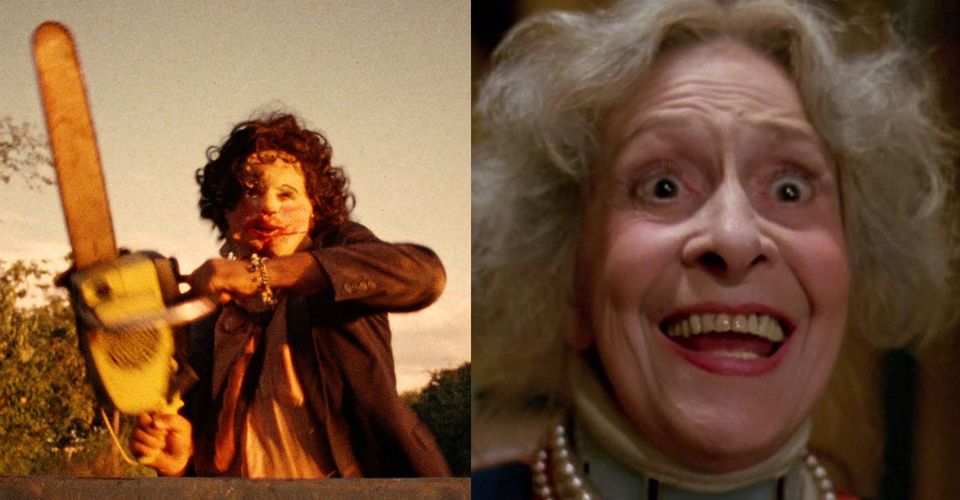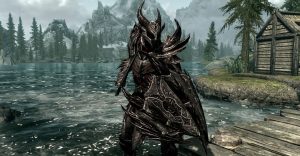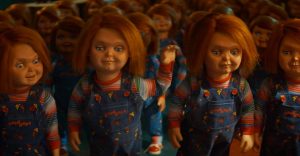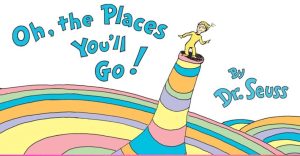10 Killer Hillbilly Horror Films

Perhaps the most American of genres, hillbilly/backwoods horror movies seem to speak to our age-old fears of what lurks in the wild, untamed corners of our country, as well as our distrust of outsiders and those who exist beyond the fringes of what’s considered “civilized” society.
Filled with cackling cannibals and bloodthirsty mutants, the best of the hillbilly horror subgenre examines where the dividing line between cruelty and compassion lies in the human animal and shows that all of us has the capacity to enact great violence when pushed to our limits. Below are ten of the best films in the subgenre.
10 Two Thousand Maniacs! (1964)

This Brigadoon-inspired (yes, really) Deep South gorefest was the second horror offering from the inventor of the “splatter” genre, Herschell Gordon Lewis. After his breakthrough exploitation hit, Blood Feast (1963). Lewis upped the ante with this tale of six people lured into a mysterious town for a Centennial celebration where the locals proceed to maim and torture them to avenge perceived injustices committed during the Civil War.
Like most of Lewis’ output, the ludicrous plot is just an excuse for some high-concept bloodletting (the most famous of which involves a barrel with nails hammered into it rolled down a hill with a lovely lady inside), but the film is notable as one of the earliest examples of a grindhouse film that paints Southerners as bloodthirsty lunatics who react to outsiders with suspicion and violence–a caricature that would spread like a moonshine-fueled wildfire.
9 Deliverance (1972)

When Lewis Medlock plans a canoeing trip with his pals to experience the grandeur of the Cahulawassee River before it’s tamed forever by a dam, the four men find themselves up to their necks in trouble when they’re attacked, raped and hunted by some monstrous locals.
An Oscar-nominated adaptation of the novel by James Dickey, John Boorman’s Deliverance is as iconic a piece of backwoods cinema as you’re likely to find. Starring Jon Voight, Burt Reynolds, Ned Beatty and Ronny Cox, the film is a complex and disturbing American classic that pokes holes in notions of traditional masculinity and explores the limits of heroism. So much more than the now infamous “Squeal like a pig” scene or its oft-parodied “Dueling Banjos” ditty Deliverance made hillbilly horror a cottage industry and lead to many knockoffs and imitators.
8 The Texas Chain Saw Massacre (1974)

An untouchable horror classic, Tobe Hooper’s The Texas Chain Saw Massacre was shot by a largely untested crew with an unknown cast one brutally hot summer in Round Rock, Texas and would go on to change the genre’s landscape.
A simple story of a group of teens who are stalked and killed by a family of former slaughterhouse workers, The Texas Chain Saw Massacre distilled something about the post-Watergate, post-Vietnam American identity down to its essence in its depiction of the country as a soulless cannibalistic hellscape, and inadvertently gave birth to the slasher subgenre that would be crystallized by John Carpenter in Halloween four years later.
7 The Hills Have Eyes (1977)

An All-American family en route to California gets stranded in a remote strip of desert inhabited by a clan of violent mountain-dwellers in Wes Craven’s meditation on violence, The Hills Have Eyes. No stranger to this thematic territory, Craven presented in Hills an inverted version of his breakout film, The Last House On The Left (1972), in which, instead of savagery visiting the average middle-class homestead, the middle-class finds itself in the home of the savage.
Both films, however, reach the same conclusion (underlining what Deliverance had delivered with more subtlety) that the line before civility and barbarism is razor thin, and that the protection of the familial group against “the other” will always strangle the supposed better angels of our nature. French New Extremity fixture Alexandre Aja remade the film in 2006 with a nuclear fallout angle that downplayed these themes, but it’s still a worthwhile watch for those who can stomach it.
6 Motel Hell (1980)

This twisted tale about a seemingly benign farmer and his sister who kidnap travelers and convert them into scrumptious meat products is an early example of a horror flick that satirizes what came before. Though director Kevin Connor reportedly set out to make a seriously scary feature with moments of grim humor, Motel Hell was received more as a straight-up spoof of cannibal/hillbilly movies by critics and audiences alike.
Mean-spirited and over-the-top with some truly unforgettable imagery (pig-headed takes on a new, literal meaning) and belly laughs, Motel Hell offers up the ickiness of the genre’s best offerings with a heaping helping of humor on the side.
5 Mother’s Day (1980)

Released by the always gross and gleefully camp Troma Studios (and directed by Charles, brother of studio founder, Lloyd Kaufman), Mother’s Day is a good deal darker and crueler than what’s typically associated with the independent genre label. When three old college friends take their annual camping trip, they’re abducted by two bone-headed men who do the bidding of their sadistic mother, who has a particular taste for rape and murder.
Mother’s Day is an uncomfortable film to watch, as it doesn’t really land as either a dark comedy or straightforward fright flick, leaving the viewer in a sort of thematic limbo. Confused tone aside, it’s the trio of female leads that make the film. Though Kaufman tends toward the exploitative, there’s a delicate hand at work in his depiction of female friendships which gives this strange and monstrous film a core of humanity and hope.
4 Just Before Dawn (1981)

The Texas Chain Saw Massacre may have inadvertently given rise to the slasher, but Jeff Lieberman’s Just Before Dawn was the first (and best) film to consciously combine hillbilly horror with the slasher template, resulting in a movie with the prurient, moment-to-moment thrills of Friday the 13th and the thematic/emotional resonance of Deliverance.
The setup is as familiar (five young people go camping in the untamed wilds of rural America only to be picked off one-by-one by a machete-wielding maniac) but with multi-dimensional, lived-in characters, a deliberate pace, alternately breathtaking/unsettling wilderness photography, a twist that grabs you like a bear trap, and an unforgettable ending, Just Before Dawn is one of the hidden jewels of 80s horror cinema and a perfect bridge between the slasher and backwoods horror subgenres.
3 Cabin Fever (2002)

Public opinion has greatly soured towards Eli Roth over the years, but watching his first feature film, Cabin Fever, it’s easy to see why he was briefly and prematurely heralded as the savior of 21st-century horror cinema. With a simple setup that defies expectation at every turn, the film sees a group of collegiates consumed by a mysterious disease infecting their isolated cabin.
Though Roth’s brand of fratboy humor has grown increasingly grating, Cabin Fever displays the director’s genre-literacy as he sets up trope-heavy plotlines that resolve in unexpected ways to keep the audience guessing. His depiction of rural communities is also slightly more multifaceted than other films on this list, and though the film is just as broad as most of his later work, Cabin Fever has weird energy and endearing oddness that makes it a must watch for fans of hillbilly horror. Avoid the 2016 remake like an especially virulent plague.
2 Eden Lake (2008)

Though the hillbilly horror subgenre is a largely American phenomenon, films about rural communities tormenting outsiders can be found across the globe. Hailing from the U.K. (a country synonymous with its own brand of backwoods terror– “folk horror”) James Watkins’ torture-porn-lite feature feels like a limey-ized modern inheritor to the themes and trappings of the hillbilly horror films of old.
Starring Kelly Reilly and Michael Fassbender as an attractive, well-to-do, upwardly mobile couple whose engagement weekend ends in bloody torture courtesy of some destructive backwater youths. Controversially, Eden Lake’s antagonists are the children of blue collar workers, a fact that comes to a sickening head in the film’s final minutes. In a certain light, the film may demonize the underprivileged, but when taken as a whole, it’s easy to see that Watkins intended to elevate his backwoods survivalist thriller into social commentary, making Eden Lake a boldly unsettling indictment of insularity, tribalism, and what he considers an increasing permissiveness towards violence in his country.
1 Jug Face (2013)

Just as Eden Lake seemed to borrow from American backwoods horror tropes, so does Jug Face crib supernatural elements from that country’s own folk horror subgenre to tell a tale of a pregnant teen stifled by her community–a community prone to sacrificing women to an unseen creature in a threatening pit.
Small in scale and carried by strong performances, Jug Face presents its mystical elements more plainly than expected, resulting in a powerful little shocker about gender roles and the dangers of groupthink.
About The Author
















